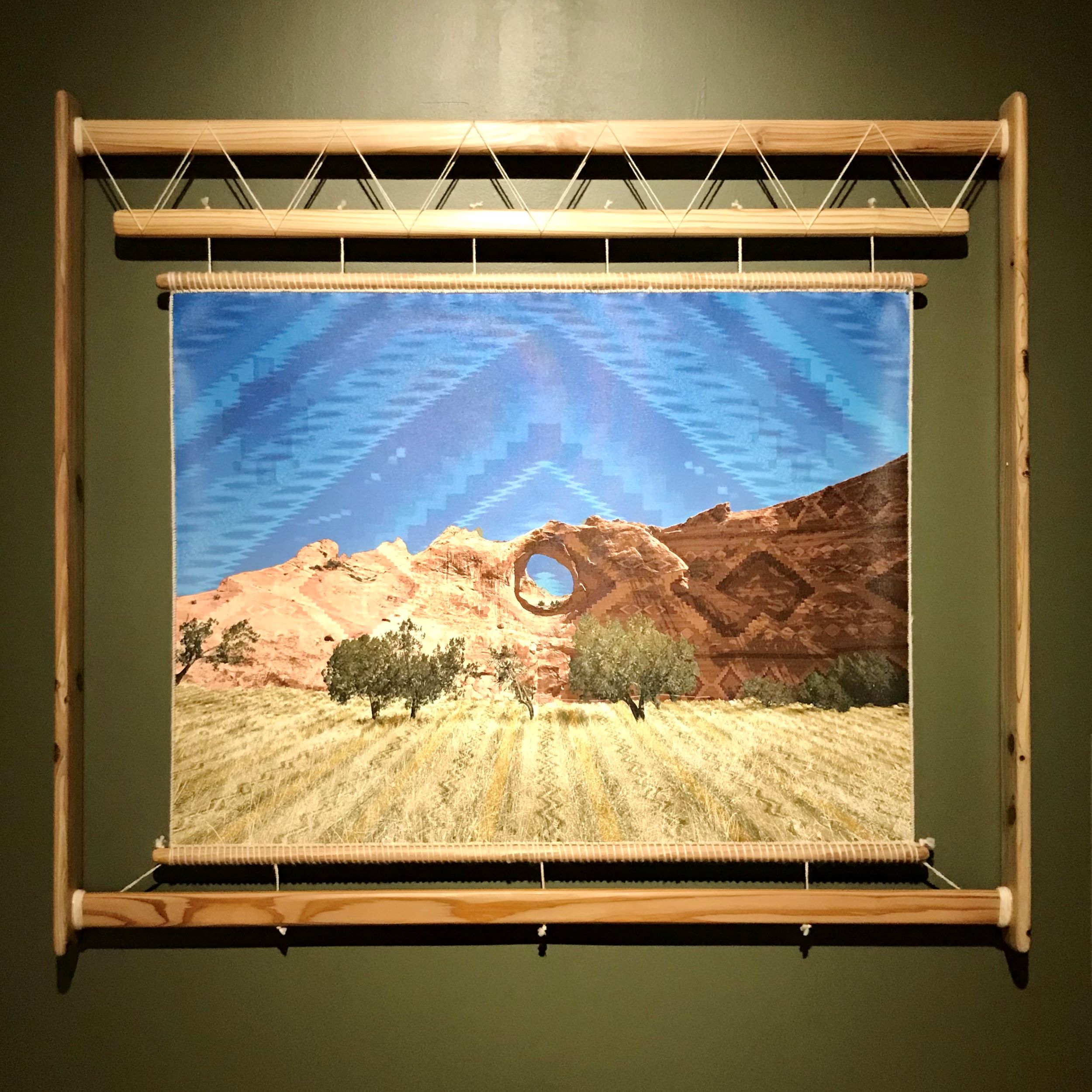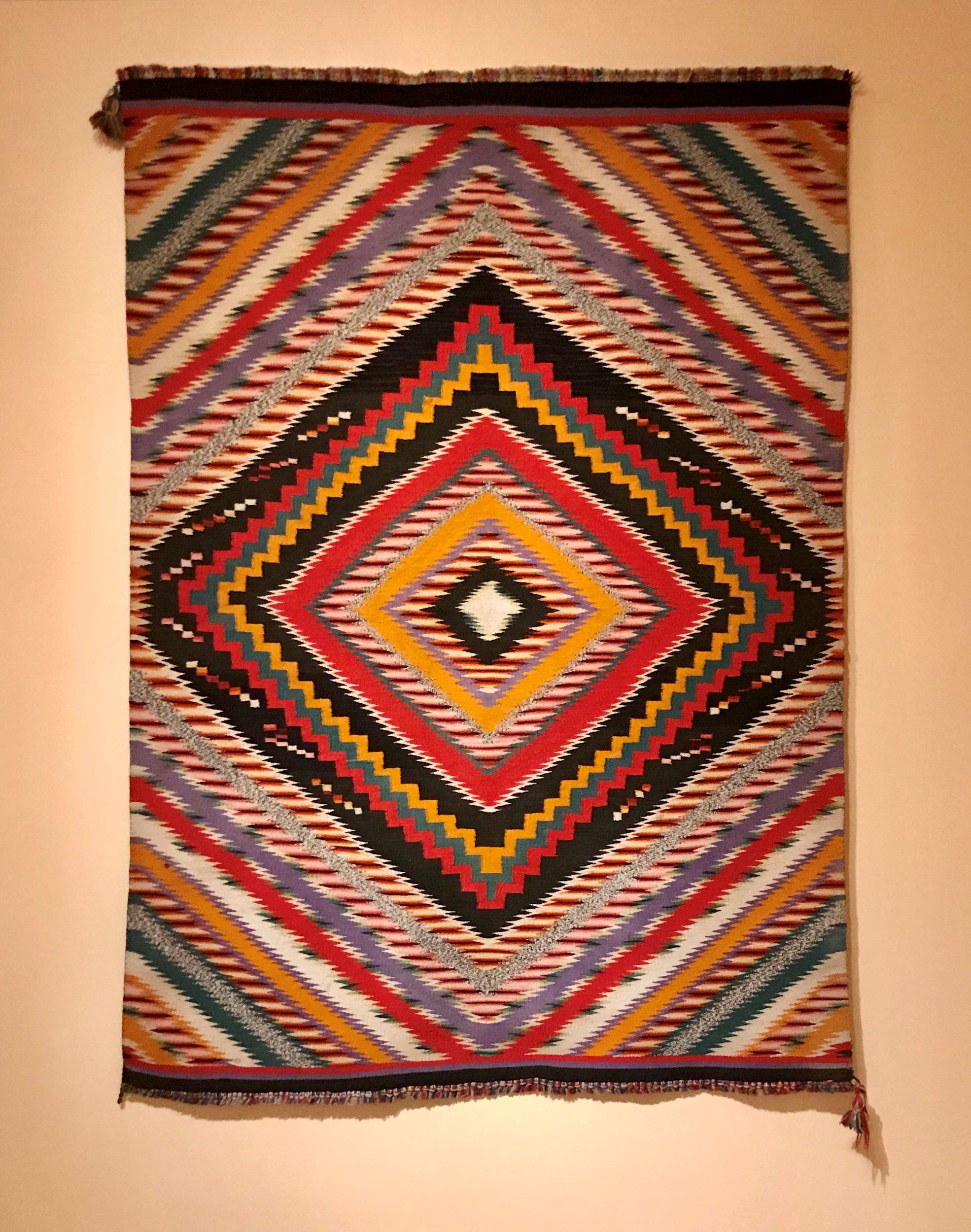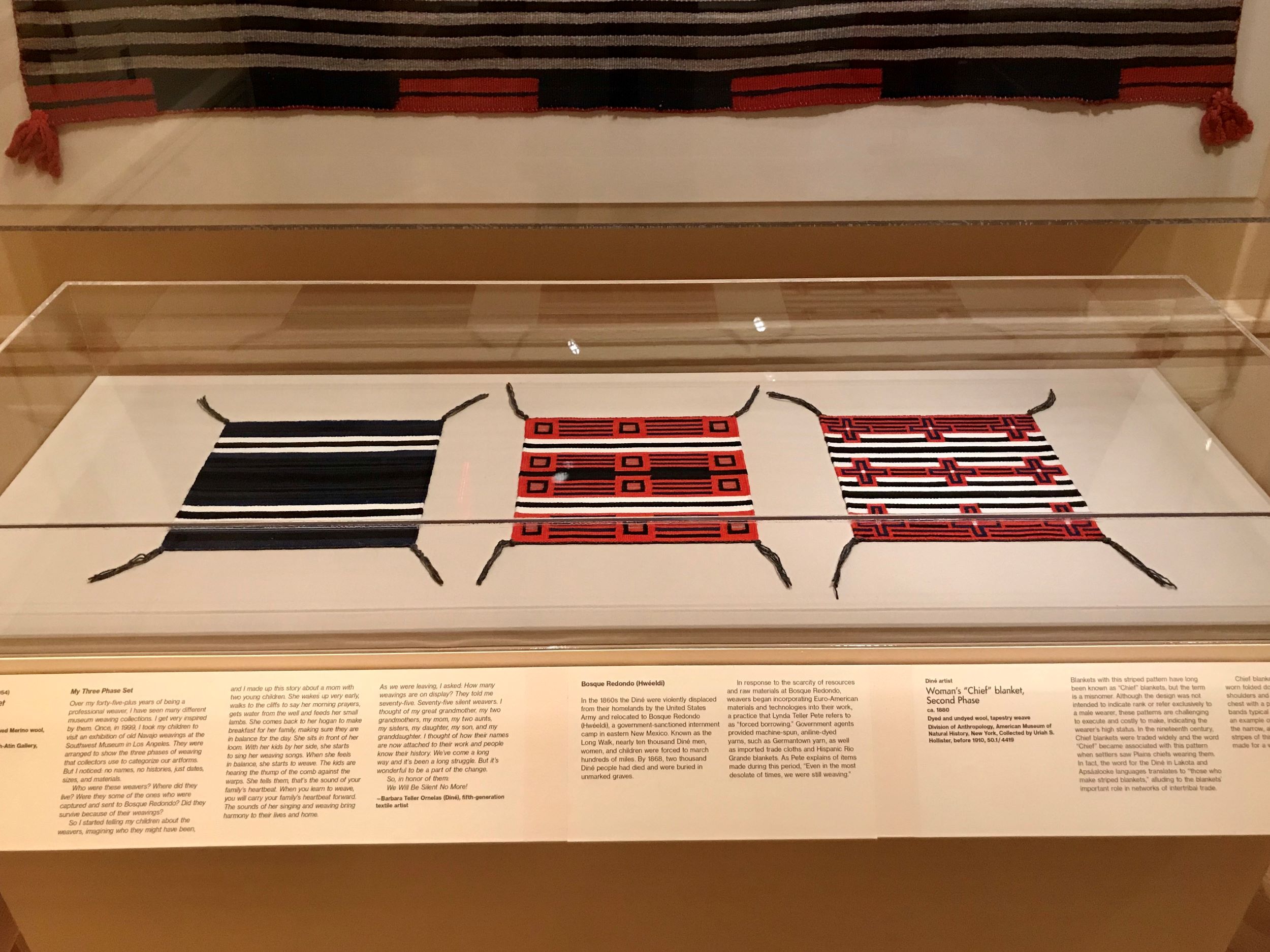Shaped by the Loom: Weaving Worlds in the American Southwest
PDF: Hawley, review of Shaped by the Loom
Curated by: Hadley Welch Jensen, with Jeanne Brako (Curatorial Consultant and Conservator), Lynda Teller Pete, and Barbara Teller Ornelas (Curatorial Advisors)
Exhibition schedule: Bard Graduate Center Gallery, New York, February 17–July 9, 2023
As Diné, our relationship to the places that we call home has been cultivated over generations, and we are inextricably interwoven with these places through continued stewardship and thriving traditions.
This quote from early-career Diné artist Darby Raymond-Overstreet appeared on the wall label accompanying her piece titled Woven Landscape, Window Rock (fig. 1). This was the first work that greeted viewers—before they even reached the title wall—in the Bard Graduate Center Gallery exhibition Shaped by the Loom: Weaving Worlds in the American Southwest. Raymond-Overstreet’s Woven Landscape is not actually woven, featuring instead a digital print rendered by layering images of turn-of-the-century Diné textiles over a photograph of Window Rock, the capital of the Navajo Nation. The geometric patterning imprints the region’s characteristic red rocks and deep-blue skies with the art production that, as the artist puts it, is “inextricably interwoven with these places,” and the image is surrounded by a frame made to resemble a loom.

The decision to introduce the show with Raymond-Overstreet’s work and words reflects curator Hadley Welch Jensen’s investment in emphasizing the continuing aesthetic customs of Diné makers, collaborating with and promoting the voices of Indigenous artists and other community members, emphasizing the place-based worldviews that Diné aesthetics are informed by, and presenting contemporary artwork of multiple media alongside historic textiles. “Navajo blankets” have been the subject of countless exhibitions since their commercial rise in the late nineteenth century, when weavers began marketing textiles to a primarily Anglo market, which used them as blankets or rugs. The Diné learned weaving techniques from the Pueblo in the mid-seventeenth century, and until the late nineteenth century, they primarily produced garments for their own use or trade with other Native and Hispanic communities. Until recently, museum and gallery presentations of Diné textiles focused almost exclusively on formal elements, neglecting to account for the voices of makers and their descendants and presenting the Diné as peoples of the past.1
Shaped by the Loom is also carefully attuned to language and the importance of using culturally specific terminology. Perhaps the most basic—but by no means universally known—example of this agenda is prioritizing the use of Diné, a term that translates to “the people,” in addition to Navajo, which is of non-Diné origin. As Diné scholar Andrew Curley explains, Navajo is a term that comes from the Spanish “Apache de Navajo,” which was derived from the Tewan and Zuni words Apachu—meaning “stranger” or “enemy”—and Nabaaju—meaning “planted fields.”2
The show was divided into seven sections that ultimately presented Diné aesthetics as a culturally significant form of knowledge production that manifests in both historic and contemporary Diné art forms. Proceeding beyond Woven Landscape, Window Rock into the gallery’s first-floor space, the viewer was met with the two sections: “Homeland, Creation, Cosmology” and “360 Experience.” The former grounded the show in Dinétah (the ancestral and present lands of the Diné), connecting customs of textile and other art productions to Na’ashjé’ii Asdzáá (Spider Woman), the first weaver, who wove the fabric of the universe from materials and knowledge gathered from the four corners of Dinétah. All subsequent weavers and other artists are thereby enacting Diné systems of knowledge as they produce their patterns, which are innately circumscribed by Dinétah, regardless of where the artist might be practicing. Further examples of Raymond-Overstreet’s works and Raphael Begay’s contemporary photography featuring Dinétah landscapes were included in this gallery, visually underscoring the cultural significance of these vistas and conceptually emphasizing that Diné art practices are vital and ongoing. Significantly, there were no textiles or historic works in these first sections; contemporary practices and voices instead provided the initial framing for the show.
The section “360 Experience” featured an immersive projection of panoramic photographs of Dinétah, with wall text encouraging viewers to “explore the varied topographies of the region and discover the material resources, vibrant patterns, and vivid colors woven from the natural world into the textiles featured throughout this exhibition.” A soundscape composed and performed by contemporary Diné musician Connor Chee accompanied the views. Nearby, a raised screen offered viewers a chance to explore the robust exhibition website, which features additional resources not otherwise included in the show.3
The site offers a permanent space for the extensive research undertaken by Jensen, Curatorial Consultant and Conservator Jeanne Brako, Curatorial Advisors Lynda Teller Pete and Barbara Teller Ornelas, and the twelve graduate students who contributed to Shaped by the Loom as part of the Bard Graduate Center Focus Project’s ongoing series of faculty-student collaborations.4 The continuing digital presence is also in keeping with COVID-era curating, which has seen a growing proliferation of exhibitions partially or entirely presented online. A web-based show is an effective way to expand viewership: anyone with internet access (not that this should be assumed, which adds another consideration) can view these materials, regardless of whether they are able to travel to see the show in person. But the format can also be limiting—there are erstwhile gallerygoers who may decide online viewership is a sufficient and more expedient way to digest an exhibition, discounting the significance of the material presence of art, meticulous exhibition layouts, and the social aspect of seeing art in person.
The physical exhibition of Shaped by the Loom continued on the gallery’s second floor, with the next section, “Ecology,” coming into view at the stairway landing. Three large nineteenth-century weavings from the American Museum of Natural History were hung side by side, drawing the viewer in with their size and symmetrical patterning. On the wall opposite, text explained the significance of the weaving process—which includes sheepherding, wool processing, and plant harvesting for natural dyes—and the ways this process arises from the transmission of generations of cultural knowledge gleaned from and connected to the local landscape. The process was further illuminated by the inclusion of sheepskin, wool samples, and historic and contemporary photographs of sheepherding.

The section “Dying and Coloring,” located in one of the rooms off the landing, emphasized both the cosmological and historic significance of color in Diné weaving and aesthetics. Colors might be seen to reference the vivid hues of the southwestern landscape, but they also have cosmological dimensions. For example, the cardinal directions of the four sacred mountains that border Dinétah are each associated with a color: east with white, south with blue, west with yellow, and north with black. Colors can also give an indication of the historical period when the maker was working; for instance, textiles comprised of bright, industrially produced threads begin appearing between 1868 and 1870, when Diné weavers started using commercial yarn from wool mills in Germantown, Pennsylvania. Design experimentation with this new material led to the development of textiles known as eye-dazzlers, in reference to their brilliant colors and zigzag patterning. Examples of these works included a Germantown blanket dated to around 1900 (fig. 2). The space also included other historic works, contemporary textiles, and photography.
The section “Knowledge and Process” was also located in this room, and it emphasized the tools required to produce Diné textiles as well as the culturally specific knowledge essential to their production. Several examples of looms were presented, with a detailed diagram explaining the cosmological significance of each element of the structure. Diné culture is guided by dualities, which wall text emphasized in explaining the multiple meanings associated with the warp and weft of the textiles:
Warp yarns, which represent male and female rain, are then interwoven with horizontal weft yarns, which represent sheep living on the earth’s surface. As the weaver slides the shuttle back and forth to add more weft, they move from one side of the loom to the other, symbolically linking night and day.
The emphasis on the tools and materials used to make the textiles on display throughout the show—evident in this section and others—foregrounded Diné epistemologies within which process cannot be separated from the finished physical piece, just as cultural knowledge necessary for textile production cannot be separated from Diné ecologies and cosmologies. This approach reflects the practices and experiences of the show organizers: Jensen, a scholar who maintains an interdisciplinary research practice that considers intersections among art, anthropology, and material culture; Brako, a textile conservationist and former longtime curator at the Fort Lewis College Center of Southwest Studies; and sisters Pete and Ornelas, award-winning fifth-generation Diné textile artists. The organizers’ broad presentation of Diné arts in Shaped by the Loom, guided by Diné worldviews rather than prescriptive non-Native assignations of artistic value, served as an effective argument for addressing Indigenous aesthetic practices in expansive terms that account for Indigenous epistemologies and thereby move beyond the narrow parameters of “art” as historically defined by non-Native arts institutions.
The room on the other side of the stairway landing featured “Design Elements,” a section considering the significance of design motifs in textile compositions. Depending on the piece and the context, designs in Diné textiles can communicate information about the weaver’s personal style, their family stories and kinship connections, Diné histories and experiences, and transcultural dialogues with non-Diné communities. Items on view in this section included Pueblo and Hispanic textiles in addition to Diné works, evincing the ways weavers in the region from different cultures influenced one another. Viewers were thereby reminded that Diné textile production has never existed in a vacuum; the practice is dynamic and ever-evolving, problematizing parameters of “authenticity” based on the fallacy of cultural purity that some non-Native scholars and collectors have used to evaluate this work.
The final section, also in this room, was “Value and Exchange,” with wall text immediately stressing that while textiles have long been an important source of revenue, the value of a piece extends beyond economic worth for many Diné weavers: “The quality of raw materials, time spent at the loom, and knowledge exchanged and inherited all contribute to its value.” Examples on view in the space included historic and contemporary textiles and one intriguing project that transcends strict separation between the two categories: fifth-generation weaver Barbara Teller Ornelas’s Contemporary Chief Set (Three Miniatures) (fig. 3). In this series of three small weavings, Ornelas replicates examples of first-, second-, and third-phase Chief blankets. These phases are categories developed by non-Native traders to describe three stylistic phases of Diné textiles mostly produced for trade during the nineteenth century. Such textiles are highly sought after by dealers, but their makers typically remain uncredited.

Ornelas began her miniature set as a way of honoring and giving voice to these historically silent women, after seeing a show of seventy-five textiles that were, as her observation on the label states, “arranged to show the three phases of weaving that collectors use to categorize our artforms. But I noticed: no names, no histories, just dates, sizes, and materials.” In a statement that broadly encapsulates Shaped by the Loom and provides an effective conclusion for this review, Ornelas registers her respect for these weavers of an earlier era: “So, in honor of them: We Will Be Silent No More!”
Cite this article: Elizabeth S. Hawley, review of Shaped by the Loom: Weaving Worlds in the American Southwest, Bard Graduate Center, Panorama: Journal of the Association of Historians of American Art 9, no. 2 (Fall 2023), https://doi.org/10.24926/24716839.18158.
Notes
- On early exhibitions of Diné weavings, see Jennifer McLerran, A New Deal for Navajo Weaving: Reform and Revival of Diné Textiles (Tucson: University of Arizona Press, 2022), 52–155. For a historiography of the scholarship around Diné textiles, see Ann Lane Hedlund, “Beyond Beauty: Exploring the Ethnoaesthetics of Navajo Weaving,” American Indian Art Magazine 40, no. 3 (Summer 2015): 44–59. ↵
- Andrew Curley, “The Origin of Legibility: Rethinking Colonialism and Resistance among the Navajo People, 1868–1937,” in Diné Perspectives: Revitalizing and Reclaiming Navajo Thought, ed. Lloyd L. Lee (Tucson: University of Arizona Press, 2014), 132, 148. ↵
- The exhibition website can be viewed at https://exhibitions.bgc.bard.edu/shapedbytheloom. ↵
- The Bard Graduate Center students who contributed to the show were Marion Cox, Natalie De Quarto, Juliana Fagua Arias, Emily Hayflick, Tova Kadish, Rachael Schwabe, Danielle Weindling, Caleb Weintraub-Weissman, Ashley E. Williams (Columbia University), Alice Winkler, and Jessica Young. ↵
About the Author(s): Elizabeth S. Hawley is Assistant Professor of Art History at the University of South Alabama.

